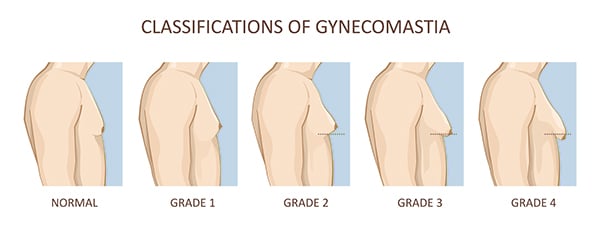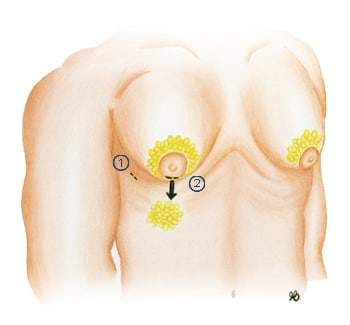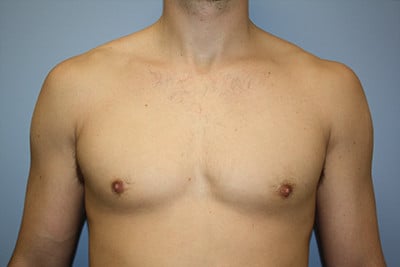Male beauty
come live the Clinimedspa
experience!
Male beauty
come live the Clinimedspa
experience!
Male beauty
come live the Clinimedspa
experience!
– How can you tell if gynecomastia has developed?
At first glance, gynecomastia can be difficult to identify early in its development. Sometimes, a man may react with embarrassment or even fear as soon as the first signs of gynecomastia appear. In addition, this discomfort may cause some patients not to want to expose their bare chests for fear of being ridiculed. In some cases, many will simply refuse to recognize the problem and seek out a way to alleviate the situation by weight training or favouring loose clothing.
Sometimes, the problem is characterized by the appearance of breasts, and the patient can end up looking more feminine. In addition, when the gynecomastia is more severe, the patient may even develop tenderness and swelling of the nipples. An accumulation of pectoral fat (adipomastia) will be observed, which is more or less linked to obesity. In addition, adipomastia can develop asymmetrically.
– What are the causes of breast development in men?
Gynecomastia has no specific cause, and it may even have multiple factors. For example, it can be caused by obesity, a hormonal imbalance, a genetic alteration, or taking certain medications. Gynecomastia can develop following the use of anabolic steroids or cannabis (marijuana).
– How do I know if I have gynecomastia or adipomastia?
As mentioned above, it may turn out that the development of breasts in men is false gynecomastia. In this case, we are looking at pectoral adipomastia without the presence of a mammary gland. In other words, this is mostly due to the accumulation of fatty tissue in the chest area. The good news, then, is that this can be resolved by combining weight loss with exercise or strength training. We also recommend combining physical activity with a healthy diet and a balanced lifestyle. If these lifestyle adjustments do not work as expected, liposuction will be enough to extract the excess fatty tissue from the breasts.
By contrast, in the case of gynecomastia, there is a development of the mammary gland. This is why it cannot be eliminated through weight training or exercise. If you think you have gynecomastia, you can do a self-assessment before seeing your doctor. First, you need to raise your arm by placing your hand behind your head. Then, you need to feel around the nipple to check if you have a lump behind or under the nipple. If you notice swelling or a hard lump, this is a sign that you probably have gynecomastia.
– What should I do if I have signs of gynecomastia?
In this case, we recommend that you make an appointment for a consultation in order to have a more in-depth examination. Once the diagnosis is confirmed, we will explain the surgery to you.
Note that it is also best not to operate during adolescence, because the gland can sometimes resolve itself spontaneously. In adulthood, however, it tends to remain stable or develop slowly.
– How do you cure gynecomastia at Clinimedspa?
Dr. Arbour proceeds with a generous tumescence of the tissues under local anesthesia in order to perform a lipo-gynecoplasty. We then perform a liposuction or sometimes only a mobilization of the gland using lateral incisions (1). The gland is excised in several fragments through the incisions under the nipples (2). This technique developed by Dr. Arbour makes it possible to achieve a more attractive result that is as consistent as possible. On the other hand, he will sometimes use drains, which are small bulbs attached to a long tube placed on the side (1). These will need to be kept in place for a period of a few days to a week to collect the liquid. Sometimes, the addition of skin tightening with radiofrequency is recommended to optimize the result.
LIPO-GYNECOPLASTY
Before/After photos
You can access our photos of gynecomastia results on our photo gallery page via the main menu or by clicking the button below. Access the photo gallery.
Clinimedspa ©
« Avertissement : Ces photos sont publiées à titre indicatif afin de fournir de l’information sur la nature de l’intervention. Elles ne constituent aucunement une garantie de résultat. »
– What type of anesthesia is used for lipo-gynecoplasty?
We perform lipo-gynecoplasty on an outpatient basis under local anesthesia with sedation for the comfort of the patient. Once the operation is complete, the patient will be able to return home with his companion just a few minutes after his operation.
– How long does the procedure take?
The surgery takes an average of 1 to 2 hours depending on the severity of the case, and longer if the procedure is combined with other treatments.
– Is liposuction always necessary?
No, it is not always necessary to have liposuction. This is the case when the patient is very thin and the mammary gland is well-located. In this situation, Dr. Arbour will suggest simply proceeding with mini-incisions (2) under the nipples in order to remove the mammary gland.
– Can the gynecomastia treatment be combined with other procedures?
Yes, if you wish, we can take this opportunity to combine several procedures. In this case, we may consider combining liposuction or Bodytite treatment in other areas of your body. The most common areas are the abdomen and flanks.
– How long is the recovery period following the operation?
The recovery time for most men ranges from a few days to 2 weeks. However, in the case of a very physical job, recovery could take up to 4 weeks. After this period, you can return to all your usual activities. For the first 6 months after the operation, we recommend that you avoid exposing your scars to the sun without protection in order to avoid hyperpigmentation.
– What are the risks of recurrence?
In 2 to 5% of cases, there may be a recurrence of the gland behind the nipple. This would be apparent within 6 months of the operation. Dr. Arbour would then have to operate again under local anesthesia to correct the problem.
Watch our Healthy Beauty video presentation




